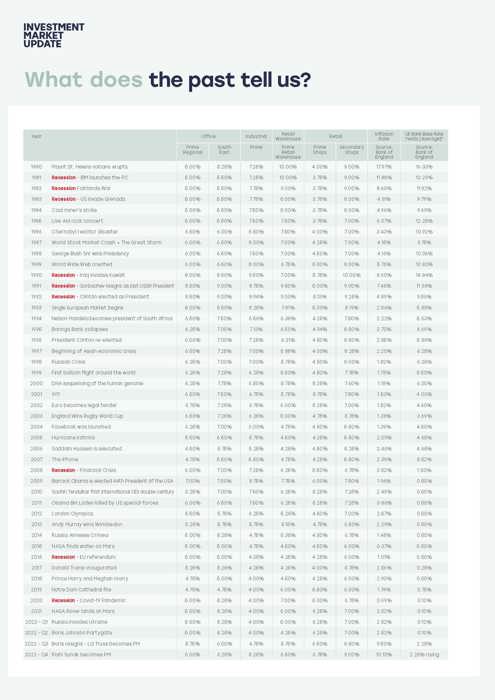Blog | Commercial Investment
Look to the past to ride out uncertain times

Since the beginning of September, the UK has gone through a series of rather unsettling events. We’ve also had three prime ministers, and you will be excused for not keeping up with the latest cabinet appointments and re-appointments – there have been far too many.
Despite the resignation of Liz Truss, preceded by the departure of Kwasi Kwarteng after the chaos caused by his mini-Budget, the impact of the shock his measures sent through the market continues to be felt and will have long-lasting consequences for our industry and the UK economy as a whole.
We’ve seen spiralling interest rates, affecting both commercial and residential property, which risks substantially restricting the volume of property transactions taking place, and understandably, the investment community is nervous. To many, it is not at all clear whether putting money into property is still a sensible thing to do, but there is hope that the appointment of Rishi Sunak as the new Prime Minister will stabilise the markets. There is still a lot of uncertainty - we may not have yet felt the full extent of the damage done by Liz Truss and her Chancellor, and it’s too early to tell if any of it can be reversed or at least mitigated by Rishi Sunak’s well-intentioned team.
Right now, some may feel like the very foundations of our society are being shaken and there is very little to fall back on given the grim headlines left, right and centre, but it’s important to stay level-headed and turn to the past to see how previous challenging economic scenarios played out and how the market reacted.
My version of a crystal ball
While the British economy is not yet, officially, in recession, many believe we're not far off - and some believe we've been in one for a while, but the yields on commercial property are still surprisingly low, indicating a potential disconnect between the pricing and the economic reality. Something has to change urgently if our industry is to weather this storm.
As the below table spanning 40+ years’ worth of data clearly demonstrates, today’s commercial property yields are still keener on the whole compared to previous recessions in the early 1990’s and the financial crisis of 2008.
Click table to view full version
Looking back at the market data from previous recessions is a useful exercise, providing us with a good point of reference and an indication of what we can expect in the not-so-distant future. According to the figures from the data collected by Allsop over the last 40 years, during the economic crises of the 80’s, 90’s, and 00’s the yields across offices, industrial and retail warehousing were much higher than they are now, so could it be that our market has got to accept a price correction in order to thrive in the future? Failing that, UK commercial property will face liquidity issues and its ability to attract new capital in 2023/4 will be further undermined.
We predict a quick and rapid price correction across all commercial property sectors, and we are witnessing this already. It will be interesting to see the severity of the correction, particularly in the industrial market and say, City offices where the occupational market appears to be holding up reasonably well. Will it be these sectors that post-correction see the first activity?
Let’s keep the market moving
For some, the inevitable need for repricing is hard to swallow but it’s a necessary step in reinstating the health of our market, much like leech therapy, which some say is good for
restoring blood circulation. We need a quick sharp correction to reflect the current lending environment which has changed brutally in the space of only four months.
Without the repricing, our market runs the risk of finding itself at the mercy of overseas buyers keen to ride the currency wave. We are starting to see the first signs of overseas interest, but is that really enough to sustain the commercial property sector over the medium-term? If past experience is anything to go by, the answer is no.
This blog was first published on 11th October 2022 by Property Week. You can see the full article here
Related Insights

It’s coming home: sports clubs become real estate’s biggest fans
Development can help generate lucrative long-term revenues for clubs

"Where would you invest £100M?" Nabeel Mussarat interviews Scott Tyler & Richard Adamson
Scott Tyler and Richard Adamson shared their views on the current property market with property investor, Nabeel Mussarat.

Behind the eyes of a junior property investment agent
So, last year in the property market? Total rollercoaster, and not the fun kind. As a not so newbie trying to crack the code,...

What might occur in the national investment market in 2024?
This time last year, our team of sector experts were hopeful of a more active market in 2023 – alas, with interest rates risi...
